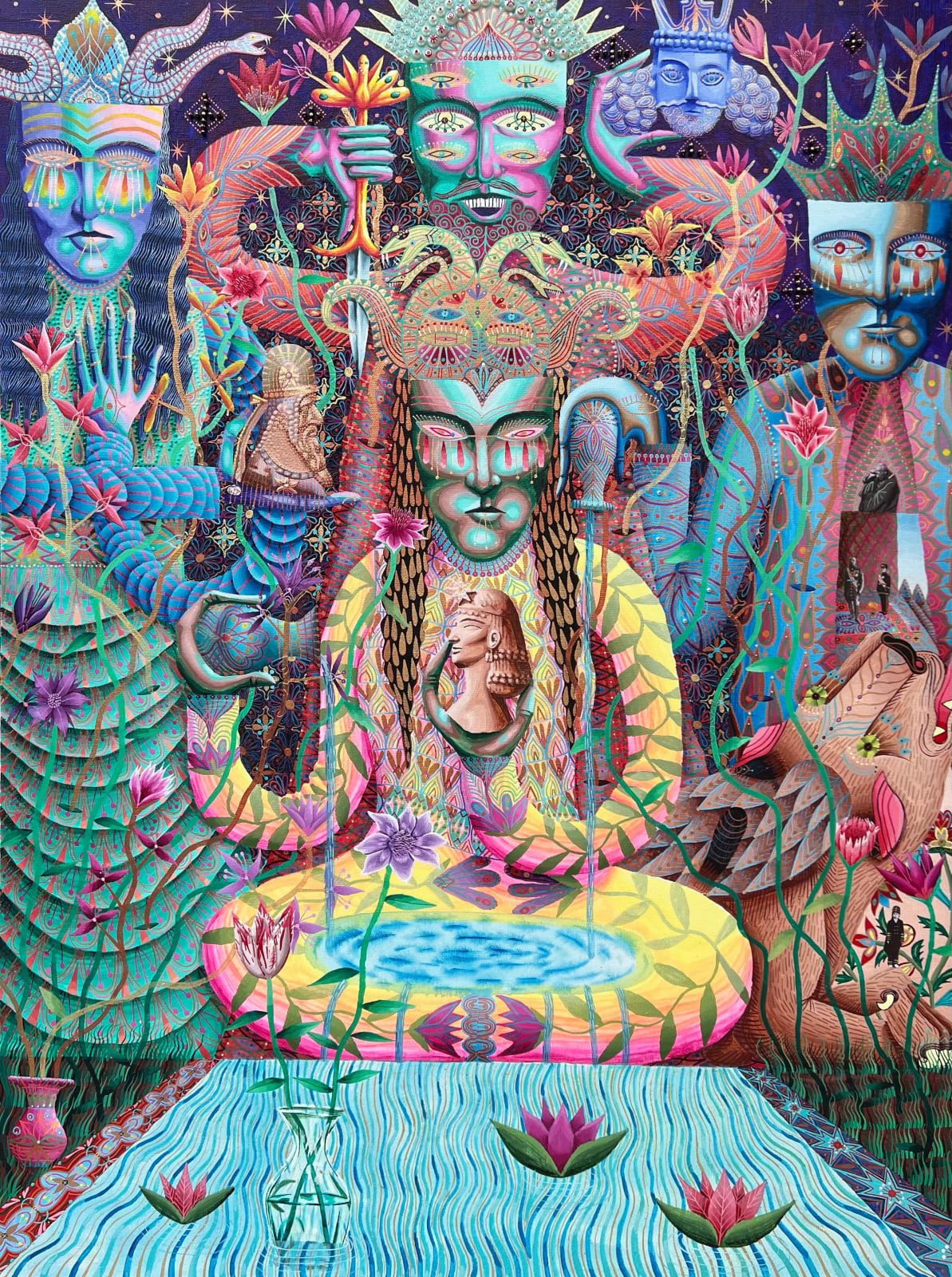Asad Faulwell American, b. 1982
Earth and Water, 2023
Acrylic and mixed media on canvas
101.6 x 76.2 cm
40 x 30 in
40 x 30 in
Courtesy of the Artist and Lawrie Shabibi
This work deals with the formation of cultural and national identity through the creation of myth and how this mythology is connected to the creation of power. The main figures...
This work deals with the formation of cultural and national identity through the creation of myth and how this mythology is connected to the creation of power. The main figures in the paintings are loosely based on Iranian historical archetypes of kings, queens and magi with imagery pulled from all eras of history dating back to the Iranian peoples pastoral nomadic origins.The figures in the paintings are masked, anonymous and often hollow. Serving less as living beings and more as architecture to prop up a narrative of identity, nationality and power. These archetypal figures contain within them vignettes that relate to more specific ancient and recent historical events in Iran, specifically the constitutional revolution of 1951 and the CIA backed coup of 1953. In this way all modernity is tied up or embedded in the mythology of the past while simultaneously becoming part of that mythology. There is also an attempt to come to grips with Asad's own familial history, broken and fractured by the political and religious upheaval of 1979.
The central priestess/magi figure holds a statuette of goddess Anahita in her hand. She pours water into her lap which then runs into a pool—A reference to both the holiness of clean water in Zoroastrian belief and to the female figure as a source of life.
The Queen figure on the left holds a statuette of Ardashir I (founder of the Sassanian kingdom) which led to resurgence of “Persian” identity and Zoroastrian belief while wiping out much of the history of other Iranian peoples that came before.
The King figure at centre top holds a peacock shaped dagger and a bust of Shapur I (son of Ardeshir) who furthered his fathers empire and legacy. At the far right is a Magi partaking in the water ritual by also pouring water into the lap of the priestess. The magi contains within his body vignettes or miniatures that outline the events of 1951-53. There is also a seated lion representing kingship and power throughout much of Iranian history, ironically also an animal hunted to extinction in the region.
The title "Earth and Water" refers to two of the holiest elements in Zoroastrian doctrine and also the preferred act of submitting during the Achaemenid empire. Conquered kings were expected to offer the Achaemenid king clean earth and water as a symbol of there submission.
The central priestess/magi figure holds a statuette of goddess Anahita in her hand. She pours water into her lap which then runs into a pool—A reference to both the holiness of clean water in Zoroastrian belief and to the female figure as a source of life.
The Queen figure on the left holds a statuette of Ardashir I (founder of the Sassanian kingdom) which led to resurgence of “Persian” identity and Zoroastrian belief while wiping out much of the history of other Iranian peoples that came before.
The King figure at centre top holds a peacock shaped dagger and a bust of Shapur I (son of Ardeshir) who furthered his fathers empire and legacy. At the far right is a Magi partaking in the water ritual by also pouring water into the lap of the priestess. The magi contains within his body vignettes or miniatures that outline the events of 1951-53. There is also a seated lion representing kingship and power throughout much of Iranian history, ironically also an animal hunted to extinction in the region.
The title "Earth and Water" refers to two of the holiest elements in Zoroastrian doctrine and also the preferred act of submitting during the Achaemenid empire. Conquered kings were expected to offer the Achaemenid king clean earth and water as a symbol of there submission.



